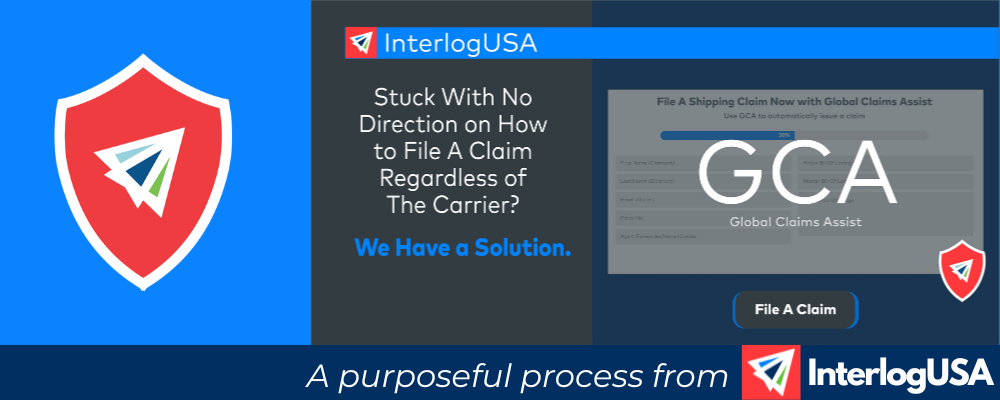Interlog  Insights
Insights
October 2023
The following is an archived collection of our weekly insights through the month of October. Those who had signed up to our Interlog Insights newsletter received each week’s update to their inbox on the original release date. If you like what you see below, please feel free to sign up yourself to get these updates right as they come!
This month's insights
- SHIELD Protocol
- Port Updates
- Cyberattacks
Week 4 - Originally released October 27
Recap: Three Weeks, Three Ports
This October in Interlog Insights, we covered three seaports—Savannah, Montreal, and Charleston—each with their own unique developments.
Week 1: Port of Savannah’s Double-Digit Backlog
In an otherwise quiet 2023 for the Port of Savannah (at least compared to yesteryears), the East Coast gateway found itself tied up with a double-digit queue of ships anchored off the shore.
This wasn’t due to a freight resurgence, but rather a few odd events and unfortunate timing.
In late August, Savannah temporarily shut down berths at its largest terminal Garden City in order to receive new crane equipment. This planned disruption wasn’t going to be a major issue until the following week Hurricane Idalia forced the port to close its shipping channels.
To top it all off, after the storm threat passed over, Labor Day promptly arrived—one of the few days each year that the port regularly closes.
This bizarre sequence of events created this surprising backlog of ships which port officials initially stated should be cleared by mid-November.
Towards the end of October, Marine Traffic data showed 13 ships anchored off Savannah’s coast.
Week 2: Port of Montreal Receives Funding for New Terminal
The Canadian government earmarked $150 million towards the construction of a new container terminal for the Port of Montral. The awarded funding comes as the country pursues more national supply chain capacity, while also expanding its reach towards foreign markets.
The imagined facility is expected to feature a 2,200-foot-long dock, a container handling yard, and road and rail access (including cargo transfer hubs). The project is estimated to increase the Port of Montreal’s total capacity by 55 percent which means it could handle over one million twenty-foot-equivalent-unit (TEU) containers per year.
The Port of Montreal is currently Canada’s second largest port, following the Port of Vancouver.
Week 3: Port of Charleston is Getting a Bridge Raised
South Carolina Ports Authority, the administrator which oversees the Port of Charleston, has announced this month that state funding has been improved for a bridge raising project.
By raising the Don Holt Bridge, which carries I-526 over the Cooper River, North Charleston Terminal, one of Charleston’s three marine terminals, will be able to handle larger world-class container ships.
The bridge’s current clearance can only allow ships up to 8,000 twenty-foot-equivalent units (TEU) capacity to pass under to the terminal. However, once the project is completed, the port authority states North Charleston will be able to handle 20,000 TEU giants.
Overall, the bridge raising will raise the roof on the Port of Charleston’s total annual throughput.
Shipper Hotline: Industry Question and Answer

Have a question about international shipping and logistics? Email our team at support@interlogusa.com
We’ll get back to you right away and may feature your question (anonymously) on our next edition of Interlog Insights!
Recap: Cyberattacks in the Supply Chain
For part of our insights during this month we focused on the topic of Cyberattacks in the Supply Chain.
In week one of October, we discussed a recent cyberattack that occurred at well-known Estes Express, which impacted several systems throughout their network. The company is slowly in process to restoring their services.
We also discussed past cyberattacks in the industry including one that occurred this year in July at the Port of Nagoya in Japan.
In week two of October, we talk about the growing challenges to avert cyberattacks. We also talk about October being cybersecurity awareness month. Which is an annual initiative first launched by the National Cybersecurity Alliance and the U.S. Department of Homeland Security.
Finally, in week three of October, we talk about why there has been an increase in supply chain related cyberattacks. A recent report showed this year to have seen twice as many software supply chain attacks than the entirety of 2019 through 2022.
We also discuss some of the main reasons why more increases are happening such as, open source software vulnerabilities, human error, and lack of encryption.
Week 3 - Originally released October 20
Insight: South Carolina Ports Announces Bridge Raising Project, Clears the Way for Giant Cargo Ships
The South Carolina Ports Authority had a big announcement this past Monday at its State of the Port address that will certainly raise the roof, or more accurately, a bridge, at the Port of Charleston.
With funding approved by the state’s Department of Transportation, South Carolina will kickstart a project to raise a major bridge in the Charleston area that will allow one of East Coast port’s terminals to handle larger cargo ships. The project’s true potential will not be achieved overnight, but when said and done, the North Charleston Terminal will expand its handling capacity from 8,000 twenty-foot-equivalent units (TEUs) vessels to 20,000 TEUs giants, including those with freight volumes moving through the Suez Canal.
The Don Holt Bridge, which carries Interstate 526 over the Cooper River, currently has a 160-foot clearance. For reference, the world’s largest classes of cargo ships require at least 200 feet of headroom for a comfortable clearance.
Given assurances that the terminal will be able to handle such vessels, it can be assumed the raised bridge will be in the clear of obstructing even post-Panamax cargo ships.
That said, in its present state, the North Charleston Terminal is the smallest of the Port of Charleston’s three marine terminals and a key exchange for a niche product – solar panels. While the bridge is raised, South Carolina Ports plans to renovate equipment and the facility layout at the terminal in order to embrace the potential surge in cargo volumes post-project – a number that’s expected to be five times its current handling capacity.
Pending necessary updates to its facility and a successful bridge raising, North Charleston will finally be competitive with its two terminal siblings – Hugh Leatherman and Wando Welch. The latter is currently Charleston’s largest terminal with an annual capacity of 2.4 million TEU.
Meanwhile, the Hugh Leatherman Terminal is also undergoing a project to expand its capacity. The facility presently has a 700,000 TEU cap, however when phase three of ongoing construction is completed around 2032, Hugh Leatherman will be at 2.4 million TEU as well.
The other type of draft
What do you think when you hear the word draft?
For most people, they’d think of military conscription or fantasy football. For on-the-clock logistics folks (pat yourself on the back!), the first thought would be the depth of port channels and how water levels limit certain vessels from calling at certain ports.
What’s not often remembered when thinking about draft is what is above the vessels. Air draft limits forms just as much as an obstacle as their water counterpart.
That said, the bridge raising project underway in Charleston is parallel to port dredging, like the Port of Houston’s Project11, a massive ship channel deepening and widening project.
Fellow Southeast port Jacksonville is also undergoing its own air draft project – however, instead of a bridge, the obstacle happens to be power lines.
Insight: Why Do Supply Chain Cyberattacks Happen?
In a State of the Software Supply Chain Report 2023 by Sonatype (a software supply chain management company), it showed that 2023 has seen twice as many software supply chain attacks than the entire period of 2019-2022.
So, why has there been such an increase in supply chain related cyberattacks?
There can be many reasons, but a few of note, per Supply Chain Brain: vulnerable open-source software, human error, and lack of encryption.
Vulnerable open-source software – while this has many benefits for organizations, it can also have its risk to application security.
This can lead systems in the organization to be vulnerable to cyberattacks and disrupting their corporate systems.
Human error – we all know mistakes can happen, unintentionally or not. And while human error is inevitable, there certainly are ways to try to combat it as best as possible.
Which is why having rigorous access control and user activity monitoring can be important. As well as training programs to bring awareness about supply chain risks.
Lack of encryption – implementing strong encryption can help ensure the security of sensitive data, and cause difficulties for any potential cyber-criminals.
The use of multi-factor authentication and end-to-end encryption can also help gain ground in combating cyberattacks.
SHIELD Protocol: Global Claims Assist (GCA)
Week 2 – Originally released October 13
Insight: Canada Awards Huge Funding for the Port of Montreal
This week, we’re headed up north along the East Coast and into Canada where the northern nation has pumped a $150 million investment to build a new container terminal for the Port of Montreal.
In a bid to harness more national supply chain capacity, the Canadian government allocated this funding under its National Trade Corridors Fund.
The NTCF is a federal program investing in transportation infrastructure that supports the country’s economy. The Canadian government has reserved $4.6 billion for an 11-year period ending 2028 to the fund.
Earlier in the week, Canada’s Minister of Transport and Quebec Lieutenant Pablo Rodriguez released a statement: “By supporting the port in its expansion project in Contrecoeur, we continue our efforts to strengthen Canada’s supply chain. This is important so that we never again have to go through product shortages like we experienced during the pandemic, or the significant price increases that came along with them.”
The merit of this new Montreal terminal, and why it was awarded a generous government grant, is endowed under the belief that an efficient and reliable transportation system will ensure supply chain resilience.
It’s true that a new terminal of this caliber would improve the Port of Montreal’s container capacity which, in return, would assist in meeting user demand and fluidity of the port’s operations.
The imagined facility is expected to feature a 2,200-foot-long dock, a container handling yard, and road and rail access (including cargo transfer hubs). The project is estimated to increase the Port of Montreal’s total capacity by 55 percent which means it could handle over one million twenty-foot-equivalent-unit (TEU) containers per year.
More volumes are code for more value. Such a development would increase the annual value of imports and exports through the port, generating more profit across Canada.
If all goes to plan, the additional terminal will further strengthen the country’s connections and competitive fervor towards foreign markets as well.
Canada’s in on Montreal – should shippers be?
The Port of Montreal is already Canada’s second largest port, following the impressive Port of Vancouver, with a diverse cargo portfolio. As a strategic transshipment center, the port isn’t just capable of handling containerized cargoes, but non-containerized, liquid bulk, and dry bulk.
Shipping line giants call at Montreal rendering the port as a key intermodal hub for North America. Its own dockside rail network connects to the country’s two national rail networks — Canadian National and Canadian Pacific Kansas City.
Before this project even, Montreal has been an attractive alternative in lieu of conventional East Coast ports. While most assume only Canadian interests benefit from the port’s strategic location and operations, in reality, there’s particular advantages U.S. shippers have enjoyed in the past.
During the height of 2022’s import frenzy, port officials at Montreal encouraged shippers to avert the Port of New York and New Jersey — which at the time was plagued by wait times and equipment bottlenecks — in favor of alleviated conditions at their facilities.
Sure, it took unprecedented market conditions for shippers to consider Montreal, an unassuming port when otherwise compared to New York, however many realized the extended transit (about 620 miles) through the St. Lawrence River paid off as their freight was docked and loaded more efficiently.
Of course, conditions along the U.S. East Coast have vastly improved since last year as no significant impacts are threatening freight flow. However, if Montreal was pinned on the maps of logistics departments, they should get on it.
For most East Coast shippers, New York will always be the first option that comes to mind. This other gateway in Canada is in a lighter weight class than America’s second largest port, however its growing capabilities coupled with savvy links to inland markets could mean a competitive edge under the right service needs and circumstances.
Webinar: Shipping's New Normal, Plus Consumer Spending
This month’s webinar features an in-depth discussion on the shipping industry’s new normal, consumer spending forecasts, and predictions on 2024. Our team also goes back into time and recounts notable industry events during the pandemic.
Insight: Cyberattacks in the Industry, Growing Challenges to Avert Them
Last week, we discussed the recent cyberattack that occurred at Estes Express. We also detailed notable cyberattacks in the industry that have happened in the last few years.
Interestingly enough, October is Cybersecurity Awareness Month.
This annual awareness initiative was first launched by the National Cybersecurity Alliance and the U.S Department of Homeland Security in October 2004. It was created as a “collaborative effort between government and industry to ensure every American has resources they need to stay safer and more secure online.”
“As we become increasingly dependent on technology designed to make our lives easier and more efficient, we also become more exposed to vulnerabilites,” said Sandra Radesky, Associate Director of Vulnerability Management as CISA.
This year Cybersecurity Awareness Month will focus on four main areas:
1. Use strong passwords and a password manager
2. Turn on Multifactor authentication
3. Recognize and report phishing
4. Update software
SHIELD Protocol: Guaranteed Milestones (GEMCA)
Week 1 – Originally released October 6
Insight: Savannah Has a Double-Digit Ship Queue
At one point in 2022, the Port of Savannah held the most notorious of titles – the most congested seaport in all of North America.
Historical demand from importers, coupled with lost faith in the West Coast, knighted this capable East Coast port as an alternative conduit for shippers to harbor their goods through. 2022, while a prosperous year for Savannah, was also an overwhelming affair, best visualized through expansive ship queues off its shore.
Flash forward to 2023 and it’s been a different year entirely. Like virtually all U.S. ports, Savannah has had minimal congestion with demand flaming out and market conditions softening tremendously.
So, it comes as a surprise to the eyes when recent vessel traffic indicates a backlog of some 17 vessels now stacked up right off the port’s coastline.
The ship queue in question off Savannah’s shoreline on October 5. Courtesy: Marine Traffic
No. We haven’t warped into an alternative universe where demand remains egregiously aggressive at the doorsteps of America’s seaports.
Rather, Savannah’s current congestion has more of a peculiar origin story. One’s that steeped in a few odd events and unfortunate timing.
In late August, the port’s largest terminal Garden City readied for the arrival of new crane equipment. This welcome party of four ship-to-shore cranes required operators to temporarily shut down Berths 1 and 9 at the terminal so the equipment could be properly discharged from the vessel which carried them.
Business as usual, right?
The following week, Savannah’s shipping channels were closed by the U.S. Coast Guard as a precaution towards Hurricane Idalia. Luckily, the port was never harmed during the storm’s path, however the impromptu closures occurred right before Labor Day – one of the few days each year that Savannah regularly closes.
Cranes plus hurricanes with Labor Day to boot equals homebrewed congestion.
Backlog expected to clear mid-November
Episodes of congestion can certainly intimidate port users. Backed up traffic is a direct result of delays in handling.
In 2021 and 2022, congestion motivated shippers to avert certain ports and adopt unconventional routings to work around areas with inflamed marine traffic.
Savannah port officials anticipate it may take until mid-November for the queue to clear while they deploy aggressive efforts to chisel away at it.
In the meantime, shippers haven’t decried any considerable impacts yet – likely accredited to a subdued peak season. However, as the pandemic-learned rule of the thumb applies, alternative service plans to best mitigate disruptions should be in place.
So, while Savannah’s backlog looks like a papercut compared to Southern California’s 70 plus ship queue in 2021, complacency and an old school way of “sticking it out” are not strategies that’ll be rewarded.
It’s exceedingly probable the Port of Savannah will have minimal congestion upon it’s mid-November timeline, however if it isn’t, where will one’s cargo be?
Will it be signed, sealed, and delivered on time or will it be basking under Atlantic sunshine, still tethered to a ship?
Alternatives will usually just stay as alternatives. Things typically work out as planned. However, when they don’t, in international shipping, the cost of not having a backup plan will always surpass the time and effort of having one in the first place.
Insight: Industry Cyberattacks - What's Been Happening Lately
Recently, Estes Express, a well-known less-than-trucking carrier, confirmed a “technical outage” that impacted several systems throughout its network.
The company released a statement saying as of now, “we cannot share an estimated time when these systems will be online and apologize to anyone affected by this situation.”
It should be noted that Estes says it’s “continuing core operations while we address this issue.”
Estes is not the only one that has been impacted by outages of similar nature.
Past outage attacks in the industry
– Back in 2020, Forward Air experienced a cyberattack, causing backups of shipments at various key markets. This cyberattack caused various shipping delays, especially for those moving to/from and between airports. Visibility of those shipments was hindered due to the ransomware attack.
– Back in 2021, South Korean shipping line HMM was targeted in a cyberattack, causing outages to their email systems. The company found no evidence that it cause a compromise of data
– In early 2022, Expeditors fell victim to a cyberattack causing them to shut down most of their operation systems.
– In early July 2023, the Port of Nagoya in Japan was hit by a ransomware attack, that disrupted cargo packing procedures early during the week, but operations resumed later in that same week.
You cannot avoid or guarantee that you will not have any cyberattacks but, conducting regular risk assessments, implementing strong password policies, having your employees knowledgeable about cybersecurity risks, and backing up critical data area all ways to help combat these attacks as best as possible.
Podcast: Episode 12 now available!
Earlier this month, Interlog’s Emily Smith and Rachel Thielen discuss China’s Golden Week holiday and its typical impacts on shippers every year.
SHIELD Protocol: Transactional Expectations (TEF)
What did you think?
In addition, please email us at support@interlogusa.com with any news or topics you’d like our experts to cover in future issues!




